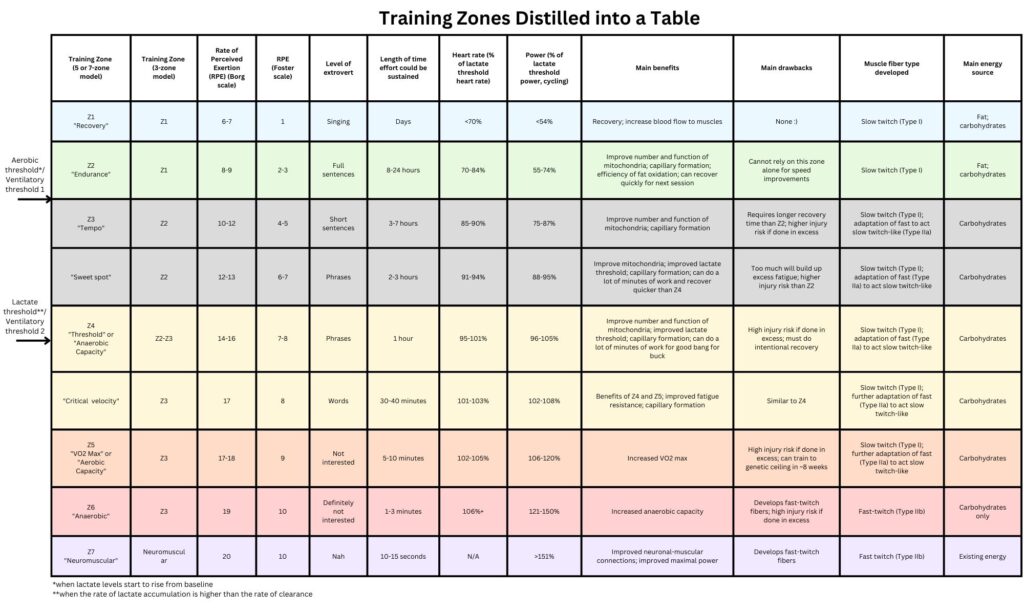I couldn’t find a table that had it all, so I made one myself.
This is a synthesis of the training zone information I’ve gathered over the past few years of coaching myself for these endurance events. There is a lot of nuance not shown in the table.
In college, I always wondered why we did the workouts we did, but I wasn’t very motivated to learn because I didn’t have any power over the workouts and also was generally pretty busy doing other things. The first couple years after college, I was mainly just learning how to do different sports without getting injured (cough cough, especially running). But now that I have been able to do those sports in some continuous capacity and with the desire to figure out what crazy things my body can do, and with no coach, I’ve had to come up with my own game plan. Understanding training zones has helped me dial in to peak for race speeds at race time, transfer workouts between sports, and grow with one sport while maintaining another.
Whether you’re curious about why you’re doing a workout, wondering how all those terms you read fit together, or coming up with your own training plan, I hope this explanation of training zones helps you! Please comment below with ideas, corrections, stories, or what you eat for dinner the night after a threshold workout 🙂

Lactate threshold heart rate and lactate threshold power (approximately FTP for cycling) refer to the steady-state heart rate and power that are obtained during a one-hour race effort. Above that effort, you will fatigue relatively quickly, and below that effort you will be able to go for longer than an hour. There are several ways to estimate these that you can find online. My favorite is just by using rate of perceived exertion!
If you determine your threshold heart rate is 175 beats per minute, here is the zone breakdown:
| Z1 | Z2 | Z3 | Sweet Spot | Z4 | Critical Velocity | Z5 | Z6 | Z7 |
| <123 | 123-147 | 148-157 | 158-165 | 166-177 | 178-180 | 178-184 | 185+ | – |
If you determine your threshold power is 250 watts, here is the power zone breakdown:
| Z1 | Z2 | Z3 | Sweet Spot | Z4 | Critical Velocity | Z5 | Z6 | Z7 |
| <135 | 136-185 | 186-218 | 219-238 | 239-263 | 255-270 | 265-301 | 302-375 | 375+ |
This was a Valentine’s Day post originally, so here was how I showed all the training love on Instagram (and here are some heart-shaped sandwich cookies for all your hard work):

Perhaps I’ll post more on workout ideas and formulating a training plan in the future! Seems to me that many years of spending time with the green heart with other (especially yellow and purple) hearts thrown in once or twice a week will get you pretty far.
Some References (again, this is accumulated over years of reading and listening to videos and podcasts, so I can’t capture them all, but these are some)
- https://joefrieltraining.com/common-but-confusing-training-terms/
- https://www.ncbi.nlm.nih.gov/pmc/articles/PMC6355121/
- https://blog.nasm.org/fitness/fast-twitch-vs-slow-twitch#fast2
- https://www.trainingpeaks.com/blog/power-training-levels/
- https://scientifictriathlon.com/tts71/
- https://www.scienceofrunning.com/2020/08/vo2max-lt-critical-velocity-they-are-much-more-messy-than-we-think.html?v=47e5dceea252
- https://twitter.com/fluidathletics/status/1618988589626580993/photo/1
